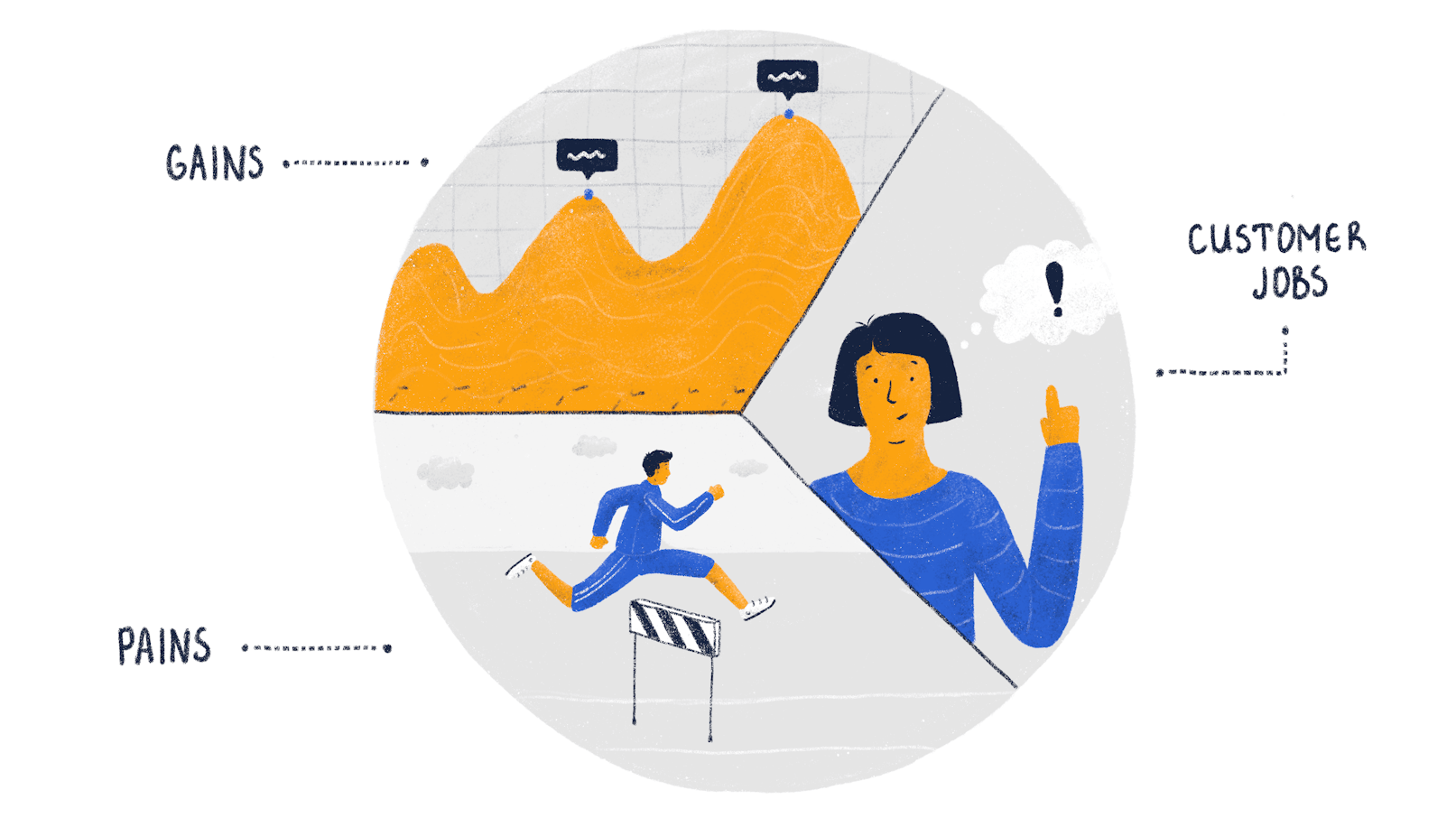As the saying goes; “Don’t find customers for your product, find products for your customers”. Data shows that around 20% of new businesses fail within the first 2 years of opening. What’s more, 45% fail during the first 5 years and 65% during the first 10 years. In fact, just 25% of new businesses make it to the 15-year mark. And the top reason behind such high failure rates? Not satisfying an actual market need. That’s where the value proposition canvas comes in.
We’re breaking down what the value proposition canvas is and how it can set your business up for long-term success.
What is Value Proposition Canvas
The value proposition canvas is a framework originally developed by Dr. Alexander Osterwalder. The goal behind the framework is to ensure that a product or service is centered around customers’ needs and values. It puts the focus on understanding customers’ problems and coming up with a solution to that specific challenge.
In a nutshell, the value proposition canvas is a tool to confirm there is a product-market fit so businesses make sure they’re building something people actually want. More importantly, it empowers your business to truly understand your customers. The framework takes stock of what your customers want to achieve, their pains, their gains, and how your product adds value to their lives.
It’s one thing to shout from the rooftops about how great your product is. However, customers need to know why. Why is your product valuable to them? At its core, the value proposition canvas looks at why customers buy.
The value proposition canvas can be used to define the product-market fit of a brand new product or service or to re-evaluate existing ones already on the market.
Now let’s explore how it works.
The value proposition canvas is developed around two building blocks: customer profile and value proposition.
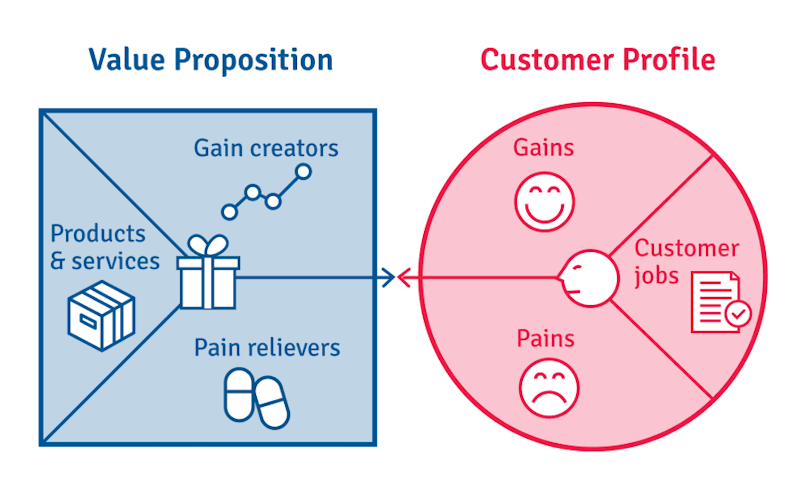
Building Block 1: Customer Profile
As the name suggests, the first building block focuses on the customer. Customer profiles, similarly to customer persons, really focus on who each customer is. Imagine you’re a private investigator. You want to dig up as much dirt as possible about who that customer is, what their needs are, and how you can meet them. In-depth research gives you the tools to tap into the emotional needs and responses of the customer, building a better sense of what they’re looking for in a product.
Since each customer segment is different, your business should create separate customer profiles for each customer segment. Listing the jobs to be done, pains, and gains for each.
A word of caution, though. Don’t fall into the trap of only including the information that fits with what your product does. The deeper you drill down, the better you can adapt to what customers really want.
Customer profiles are broken down into three categories:
Customer jobs: What problem is the customer trying to solve? Is there a specific need they are trying to satisfy? What practical, emotional, or social task is the customer attempting to perform?
Gains: What positive impacts does the customer expect? How can you exceed those expectations? What needs to happen to boost the chances of adopting a value proposition?
Pains: What are the risks, negative experiences, or emotions that the customer goes through in the quest to get the job done?
Now let’s take a closer look at each category, starting with customer jobs.
Customer Jobs
Here’s the million-dollar question: What type of tasks do you help your customer carry out? Let’s take automobile manufacturer Toyota, for example.
When defining the customer profile for Toyota customers, you could include the following jobs:
Traversing short distances
Personal mobility
Commute
Family trips
Don’t stop there, though. On top of the more obvious jobs, there are also social functions that drive customers’ choices. For instance, garnering a successful image and matching their peers’ in terms of social status.

Pains
Unsurprisingly, pains refer to the obstacles or frustration points the customers may face. What is standing in their way? To give you a clearer idea, let’s take a look at Airbnb.
While booking through Airbnb undoubtedly comes with plenty of gains; value for money, authentic local experience, etc, there are also several pains. For example:
Safety concerns regarding sharing a living space with strangers
Uncertainty about the quality of the accommodation
Mobility challenges
Too many options on offer making it difficult to choose the right accommodation
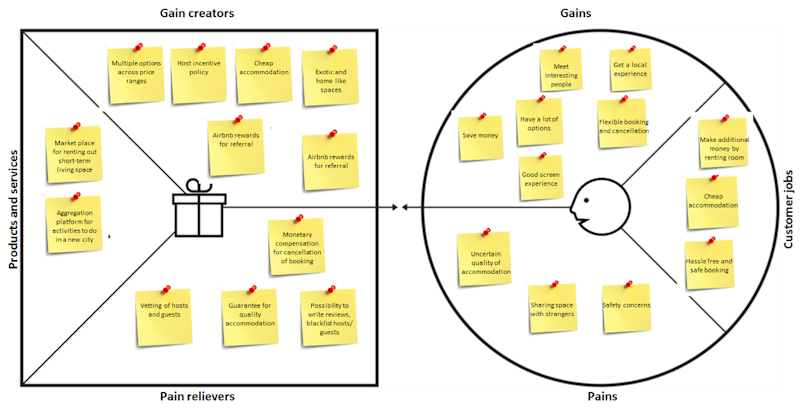
In short, the list of pains outlines all the potential barriers in place that prevent the customer from getting the job done. You know what they say, “No pain, no gain”. Thus, the more exhaustive the list of pains, the better your business will understand its customers and their needs. Plus, if you focus on turning those pains into gains, you’ll be able to increase bookings for your Airbnb.
Gains
Gains are the positive outcomes your customers are trying to achieve. When defining the gains of your product or service, factor in social benefits, financial gains, and practical functionality.
Let’s take Tesla as an example. Here are the gains:
High safety ratings
Social status - brand recognition
Innovative design and technology
High-end battery life
As you can see, the gains don’t just answer the practical jobs to be done, but also the jobs surrounding social image and status.
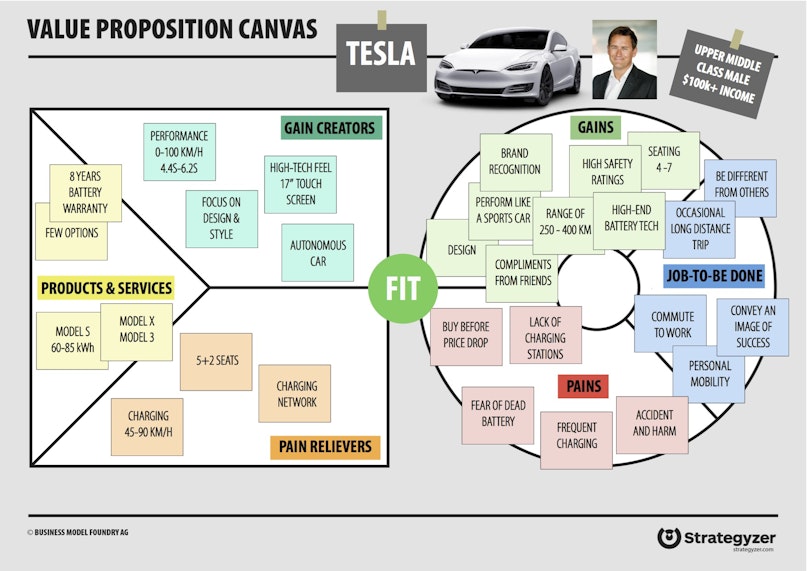
Building Block 2: Value Map
Ok, so you’ve nailed the customer part. Congratulations! But that’s just half the battle. Now it’s time to match that with what you’re offering. Don’t forget, the value proposition canvas is a blueprint. Therefore, you really need to get it right to ensure you build your product on a solid foundation.
Just like our first building block, the value proposition is divided into 3 categories:
Gain creators: How does your product or service create customer gains? What value does it add to the customer? What can you offer customers to help them make these gains?
Pain relievers: How exactly will your product or service alleviate customer pains?
Products and services: What product or service are you offering to create customer gains, relieve pains, and ultimately create added value for the customer?
Can we offer you some advice? Avoid silver bullets. One of the most common mistakes businesses make when defining the products and services in the value map is making their product sound like a silver bullet. You know, a too-good-to-be-true, quick-fix solution. When listing your product or service in the value proposition, make sure it is realistic and not some sort of magic weapon.
Before we dive into the value proposition categories, we want to quickly underscore how a product-market fit is achieved. Put simply, a good fit happens when the product or service offered addresses the core pains and gains from the customer profile. This then needs to be validated through market research and customer feedback.
Now let’s look at each category in more detail and see how our brands stacked up in terms of the value proposition.
Gain creators
Gain creators are the tangible benefits your product or service can offer customers. In the case of Toyota, there are 4 gain creators this product can deliver to customers to help them fulfill the gains:
Hybrid car
Urban style
Focus on comfort and space
Adaptive cruise control
Do you remember the gains established in Toyota’s customer profile? We’ll remind you quickly. The gains included commutes, family trips, short-distance drives, and personal mobility. In essence, the gain creators align with the gains established in the customer profile. Therefore, there is a good product-market fit.

Pain relievers
Picture this. You go to your doctor with a pain in your leg. What is your expectation? You expect the doctor to help you fix the pain, right? Your hope is that the doctor will identify the root cause of the pain and then offer you something to relieve your discomfort. Well, the same goes for your organization’s product or service.
The key is to be explicit about how you help your customers alleviate their pains. Let’s take another look at Airbnb.
We already identified some of the pains customers experience, such as safety concerns, uncertainty about the quality of the accommodation, and overwhelming option choices. Now let’s see how Airbnb can relieve those pains:
Vetting of hosts and guests
Reviews and the option to blacklist hosts or guests
Quality guarantee for accommodation
Money-back guarantee for canceled bookings
As you can see, Airbnb offers relevant pain relievers to directly address the most common customer pains.

Products and services
And now we reach the final piece in the puzzle; the product or service on offer. Let’s circle back to Tesla to discuss this one.
In terms of gains, Tesla boasted high safety ratings, social status connected with brand recognition, innovative design, and high-end battery life. These gains help Tesla customers get the job done. In this customer’s case, the job is to commute to work, convey a successful image, and stand out from the crowd.
So, it comes down to this. What Tesla products help the customer achieve this?
Here are the answers:
Model X
Model 3
Model 5
All three models come with an eight-year battery warranty and answer the needs, desires, and pains a Tesla customer has.

Identifying Competitive Advantage
The value proposition canvas has another exciting trick up its sleeve. It allows your business to identify a viable differentiation strategy. If you’re unfamiliar with the term, it’s that special something your business has that your competitors don’t. Of course, the thing that sets you apart needs to be something that your potential clients value.
Businesses can use the matrix below to make sure that their value proposition stands out from their competitors, thus giving them a competitive advantage. By doing so, the business can identify core messages and areas for improvement. For instance, core messages should resonate with a wide audience and be featured in marketing efforts. Areas for improvement could include customer education, refinement of the product, or a stronger differentiation strategy.
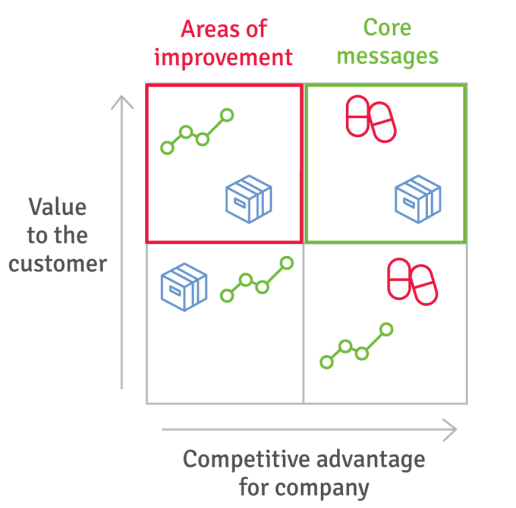
Where to Source Information
The value proposition canvas is an invaluable tool for businesses. Especially for those in their infancy. However, the results you’ll garner will largely depend on the information you’ve sourced. The last thing you should do is rely on assumptions or hunches.
We’ll be more specific. There are 3 reliable ways that we recommend to source information about your customers when creating a value proposition canvas. Let’s take a closer look.
Secondary Research
Research is king. Nowadays there is a wide array of resources available online where you can gather industry reports. While it’s true that these papers won’t answer very specific questions, they can most certainly steer you in the right direction. What’s more, they can give you food for thought or reasons to doubt your ideas.
As they say, knowledge is power. The more you know, the more in-depth your value proposition canvas will be. After all, it’s not often you hear businesses lamenting being too informed about the industry, is it?
User interviews
As UX designers, we may be biased. However, user interviews are the most powerful way your business can reveal insights into customers and their pains. During these user interviews, it’s all about asking the right questions. The interviews should be centered around uncovering the users’ problems. We don’t advise asking customers for solutions, though. It’s unlikely that customers are aware of the optimal solution to their pain points. That’s where designers come in.
As much as we love user interviews, it’s important to note that they shouldn’t be taken as gospel. You’ll find that there is always a discrepancy between what users say, do, and pay for. As such, stay mindful of this and don’t pin everything on user interviews alone.
Competitive analysis
Let’s face it. If the product you’re building has no competition, chances are either you’re an unprecedented genius or the idea isn’t viable. No offense, but we’re betting on the latter.
It doesn’t matter if you’re building a simple product or one complex enough to make the mind boggle. When push comes to shove, you’re solving a problem. If the problem is important enough, customers will have a solution no matter how effective it is. Therefore, you need to be aware of what is currently on offer in the market so you can do better. If there is already a super simple solution to the problem on the market, you may have your work cut out for you.
Conclusion
The number 1 reason why businesses fail is due to a lack of market need. Put simply, they forget to ask why they’re making the product or service. At its core, the value proposition canvas gets to the heart of why customers buy. This ensures there is a good product-market fit and that the product or service is something customers actually need and want.
At the end of the day, you can have the best product in the world. But, if nobody needs it your business is going to fail. The value proposition canvas anchors the customer at the center of the process, building products around the customer rather than vice versa.

